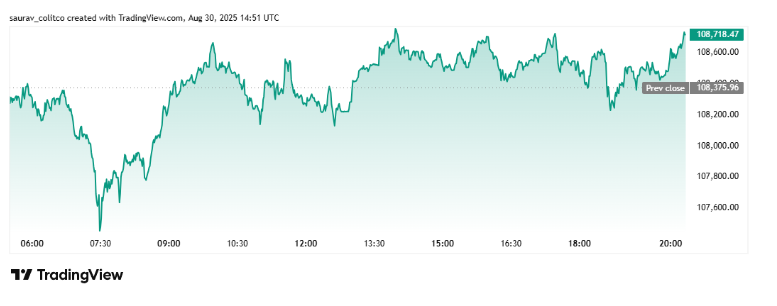The world’s largest cryptocurrency faces mounting pressure as economic headwinds converge to challenge its resilience. Bitcoin has experienced significant volatility throughout 2025, with prices swinging between record highs near $109,000 and sharp corrections below $75,000. The digital asset’s performance reflects broader market uncertainty as investors grapple with persistent inflation and escalating trade tensions.
Recent data reveal a complex relationship between Bitcoin inflation tariff pressure and market dynamics. While traditional safe-haven assets like gold have benefited from economic uncertainty, Bitcoin’s role as a hedge remains contested amid heightened volatility.
Current Market Landscape: Bitcoin’s Volatile Journey
Bitcoin’s 2025 trajectory has been marked by extreme price swings that mirror broader economic anxieties. After reaching all-time highs above $109,000 in January, the cryptocurrency faced significant selling pressure as tariff announcements triggered market-wide corrections.
The cryptocurrency falls with inflation concerns becoming increasingly pronounced. Current U.S. inflation stands at 2.7% annually as of July 2025, according to the Bureau of Labor Statistics. This figure represents a persistent challenge for Federal Reserve policy makers who continue to monitor price pressures across the economy.
Key market metrics highlight Bitcoin’s current position:
- Current Trading Range: $78,000 – $95,500
- 30-Day Volatility: Increased 40% from historical averages
- Market Cap: Approximately $1.75 trillion
- Daily Trading Volume: $15-25 billion across major exchanges
The American Bitcoin initiative launched by Eric Trump demonstrates continued institutional interest despite market turbulence. This project represents the Trump family’s strategic positioning within the digital asset ecosystem.
Tariff Impact on Bitcoin Price: Trade War Consequences
The impact of tariffs on bitcoin price has become increasingly evident throughout 2025. President Donald Trump’s aggressive trade policies, including a proposed 125% tariff on Chinese goods and 25% levies on Canadian and Mexican imports, have created significant market disruption.
Analysis from Grayscale Investments suggests that while tariffs present short-term headwinds for digital asset valuations, they may ultimately support Bitcoin adoption over the medium term. The research firm notes that tariffs contribute to stagflation—a combination of slow growth and rising prices—which historically favours scarce commodity assets.
Timeline of Tariff-Related Market Moves:
- April 3, 2025: Bitcoin dropped 5.4% following new tariff announcements
- April 6, 2025: Cryptocurrency markets lost $2.26 billion amid trade tensions
- May 12, 2025: Temporary tariff reductions led to Bitcoin recovery past $105,000
- August 2025: Market stabilisation as investors adapted to policy uncertainty
The stock market has also reflected these concerns, with traditional equities experiencing similar volatility patterns. This correlation suggests that Bitcoin continues to trade as a risk asset rather than a safe haven during periods of geopolitical stress.
Inflation and Tariff Pressure on Crypto: A Double Challenge
The combination of inflation and tariff pressure on crypto markets creates a complex investment environment. Current economic data shows core Consumer Price Index (CPI) rising 3.1% year-over-year, while tariff-related price increases threaten to push inflation higher.
Federal Reserve Chair Jerome Powell has acknowledged that tariffs could contribute to inflationary pressures, though he characterised these effects as potentially temporary. However, the broad scope of proposed trade measures has raised concerns about sustained price increases across consumer goods categories.
Inflation’s Multi-Faceted Impact on Bitcoin:
Positive Factors:
- Fixed supply of 21 million coins offers scarcity appeal
- Growing institutional adoption as inflation hedge
- Weakening dollar potentially benefits alternative assets
Negative Factors:
- Higher interest rates reduce appetite for risk assets
- Reduced consumer spending affects speculative investments
- Correlation with tech stocks during market stress periods
The ASX 200 and other global indices have shown similar sensitivity to inflation data, reinforcing Bitcoin’s connection to broader financial markets.
Institutional Adoption Amid Market Turbulence
Despite short-term volatility, institutional adoption continues to provide underlying support for Bitcoin markets. BlackRock’s iShares Bitcoin Trust (IBIT) has emerged as a dominant force, accumulating over $70 billion in assets under management.
Key institutional developments include:
- Harvard University: Disclosed $116 million position in IBIT as of June 2025
- ETF Inflows: Spot Bitcoin ETFs attracted $35 billion in 2024, with projections for $70 billion in 2025
- Corporate Treasury Adoption: Growing number of companies adding Bitcoin to balance sheets
The cloud mining sector continues to attract individual investors seeking cryptocurrency exposure without direct ownership complexities. Platforms like QFSCOIN and XY Miners have capitalised on growing interest in passive income strategies.
ETF Performance Metrics:
BlackRock IBIT:
- Assets Under Management: $70+ billion
- Daily inflows averaging $63-356 million
- 19-day consecutive inflow streak (longest of 2025)
Market Impact:
- ETFs now hold approximately 3.72% of total Bitcoin supply
- Reduced 30-day volatility by 40% compared to pre-ETF levels
- Enhanced price stability during market stress periods
Bitcoin as Risk Asset vs. Safe Haven Debate
The ongoing debate over Bitcoin’s classification continues to influence investment strategies. Recent market behaviour suggests the cryptocurrency trades more as a risk asset than a traditional safe haven during periods of economic stress.
Correlation analysis reveals:
- S&P 500 Correlation: Approximately 0.76 (historically high)
- Federal Funds Rate Correlation: -0.65 (inverse relationship)
- Gold Correlation: 0.11 (traditionally low)
This data indicates that Bitcoin remains sensitive to equity market movements and Federal Reserve policy decisions. The relationship with traditional markets has strengthened as institutional participation increases.
During the April 2025 tariff announcements, Bitcoin’s 12% price decline mirrored broader risk asset sell-offs. However, the cryptocurrency’s subsequent recovery demonstrated resilience and growing institutional support.
Global Economic Context and Policy Implications
The broader economic environment continues to shape Bitcoin’s investment narrative. Central bank policies, geopolitical tensions, and trade relationships all influence cryptocurrency market dynamics.
Current global factors include:
Monetary Policy:
- Federal Reserve maintaining 4.25%-4.50% interest rate range
- European Central Bank signaling potential rate adjustments
- Bank of Japan slowly tapering quantitative easing measures
Geopolitical Tensions:
- U.S.-China trade negotiations creating market uncertainty
- Canadian dollar weakness amid USMCA renegotiation talks
- Middle East conflicts supporting oil prices and inflation concerns
Market Structure Changes:
- Growing cryptocurrency integration with traditional finance
- Regulatory clarity improving in major jurisdictions
- Infrastructure development supporting institutional participation
Technical Analysis and Market Outlook
From a technical perspective, Bitcoin faces several key levels that will determine near-term price direction. Current support levels around $90,000 represent crucial psychological and technical barriers.
Key Technical Levels:
Support Zones:
- Primary: $85,000-$90,000
- Secondary: $78,000-$82,000
- Critical: $65,000-$70,000
Resistance Areas:
- Near-term: $100,000-$105,000
- Medium-term: $110,000-$115,000
- Long-term: $125,000-$130,000
Market structure indicators suggest Bitcoin remains in a consolidation phase following its early 2025 highs. Trading volumes have stabilised, though they remain elevated compared to historical averages.
The mining sector continues to adapt to current market conditions. Companies like Six Mining and Ripplecoin have adjusted operations to maintain profitability amid price volatility.
Future Scenarios and Investment Considerations
Looking ahead, several scenarios could influence Bitcoin’s trajectory through the remainder of 2025 and beyond.
Bullish Scenario:
- Trade tensions ease, reducing market uncertainty
- Inflation moderates, supporting risk asset valuations
- Continued institutional adoption drives demand
- Federal Reserve begins cutting interest rates
Bearish Scenario:
- Escalating trade wars damage global growth prospects
- Persistent inflation forces aggressive monetary tightening
- Regulatory challenges emerge in key jurisdictions
- Economic recession reduces appetite for speculative assets
Base Case Scenario:
- Continued volatility as markets adapt to policy changes
- Gradual institutional adoption providing price support
- Regulatory clarity improving investment conditions
- Bitcoin establishing trading range between $80,000-$120,000
Investment Strategies for Current Environment
Given the complex interaction between Bitcoin inflation tariff pressure, investors should consider several strategic approaches:
Portfolio Allocation Strategies:
Conservative Approach (2-5% allocation):
- Focus on dollar-cost averaging during volatility
- Emphasis on established ETFs like IBIT
- Long-term holding perspective
Moderate Approach (5-10% allocation):
- Combination of direct Bitcoin holdings and ETFs
- Tactical trading during major price swings
- Cloud mining exposure for diversification
Aggressive Approach (10%+ allocation):
- Direct cryptocurrency holdings
- Options and derivatives strategies
- Active trading based on macroeconomic catalysts
Risk Management Considerations
The current environment requires enhanced risk management practices. Investors should consider several factors when positioning for Bitcoin exposure:
Market Risks:
- High volatility during policy announcement periods
- Correlation with equity markets during stress
- Regulatory uncertainty in key jurisdictions
Operational Risks:
- Custody and security considerations
- Exchange counterparty risks
- Technical infrastructure dependencies
Macroeconomic Risks:
- Interest rate sensitivity
- Currency fluctuation impacts
- Global recession possibilities
Conclusion: Navigating Uncertainty
It’s journey through 2025 reflects the broader challenges facing global financial markets. The interplay between inflation pressures, trade policy uncertainty, and institutional adoption continues to create a complex investment environment.
While short-term volatility remains elevated, the underlying trend toward institutional acceptance provides structural support for cryptocurrency markets. The development of Bitcoin mining infrastructure and regulatory clarity in major jurisdictions suggests continued evolution toward mainstream adoption.
Investors should maintain a balanced perspective, recognising both the opportunities and risks inherent in current market conditions. The Bitcoin inflation tariff pressure narrative will likely continue influencing price action as policymakers navigate economic challenges.
The cryptocurrency’s ultimate role as either a risk asset or safe haven may depend on how successfully it demonstrates independence from traditional market correlations during future stress periods. Until then, disciplined risk management and strategic positioning remain essential for capitalising on Bitcoin’s long-term potential.
Frequently Asked Questions
Q: How do tariffs specifically impact prices? A: Tariffs create market uncertainty and can reduce global liquidity, leading to Bitcoin selling pressure as investors flee risk assets. However, they may also increase it’s appeal as a hedge against currency debasement.
Q: Is it a good hedge against inflation? A: Bitcoin’s fixed supply makes it theoretically attractive as an inflation hedge, but its high volatility and correlation with risk assets can limit its effectiveness during short-term inflationary periods.
Q: How does Federal Reserve policy affect cryptocurrency markets? A: Higher interest rates typically reduce demand for speculative assets like , while lower rates can increase crypto investment flows. Bitcoin shows a -0.65 correlation with Fed rates.
Q: What role do institutional investors play in Bitcoin’s price stability? A: Institutional participation through ETFs has reduced Bitcoin’s volatility by 40%, providing more stable demand and professional custody solutions that attract traditional investors.
Q: Should investors buy during market downturns? A: Dollar-cost averaging during volatile periods can be effective for long-term investors, but short-term traders should consider technical levels and broader market conditions before making large positions.












